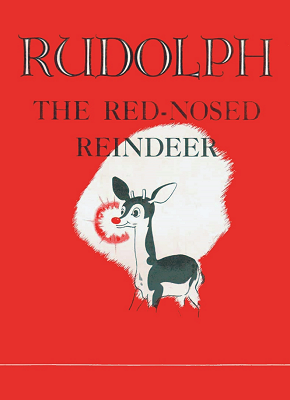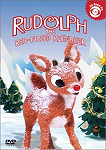 Christmas Traditions »
Christmas Traditions »
The History of Rudolph
the Red-Nosed Reindeer
Most of us are familiar with Rudolph the Red-Nosed Reindeer, a beloved figure of childhood and Christmas lore. But when did Rudolph become a part of our holiday tradition? The names of Santa's team of eight flying reindeer were established in the poem A Visit From St. Nicholas, published in 1823, but it was in 1939 that the character of Rudolph, "the most famous reindeer of all", was first introduced.
For several years during the first part of the 20th century, the department store Montgomery Ward, based in Chicago, had hired outside firms to create Christmas books as promotional items. The coloring books were given away to children as holiday gifts by their store Santa in an effort to entice parents to visit and shop at the store. In 1939, nearing the end of the Great Depression, Montgomery Ward chose to appoint a company employee to create the coloring book. The task was assigned to 34-year-old Robert L. May, a Montgomery Ward copywriter.
A graduate of Dartmouth College, May was undergoing difficulties in his life. At the time, May's young wife Evelyn was losing her battle with cancer and had now been bedridden for several years. He had a growing pile of medical bills from his wife's treatment and was caring for their four-year-old daughter Barbara as her mother's condition worsened. Despite the hardships he was enduring, May embarked on his new assignment.
Taunted for his shyness and small stature in his youth, May used that experience, as well as inspiration from The Ugly Duckling story, to create the adventure of a misfit reindeer with a glowing red nose. Though he briefly considered Rollo and Reginald, May settled on Rudolph as his character's name. He began writing the story in rhyming verse, using his young daughter Barbara as a sounding board. Though his daughter loved the tale, his employers hesitated when he presented the idea to them, worrying that red noses were too often associated with the overindulgence of alcohol. In order to persuade them, May and fellow Montgomery Ward employee Denver Gillan from the art department visited Chicago's Lincoln Park Zoo, where Gillan observed and sketched reindeer. After viewing Gillan's drawings, May's employers were convinced and his story was given a green light.
During the 1939 Christmas season, 2.4 million copies of Rudolph the Red-Nosed Reindeer were distributed. Sadly, Evelyn May passed away around the time Rudolph was nearing completion. Though Rudolph the Red-Nosed Reindeer was popular, with 6 million copies in circulation by 1946, the rights belonged to Montgomery Ward since May was in their employ when he created the tale. Facing a mountain of debt due to his wife's medical bills, May was unable to market or enjoy any profits from the story. However, in 1947 May approached and convinced Sewell Avery, the company's corporate president, to turn the copyright over to him.
In the meantime, May had met and married Montgomery Ward secretary Virginia Newton and the couple eventually had three children together. With rights to the Rudolph story in hand, May's financial future was now secure and his life had taken a happier turn. In 1947, Rudolph the Red-Nosed Reindeer was released commercially in book form.
However, Rudolph's popularity soared when May persuaded brother-in-law and songwriter Johnny Marks to create a song based on the story. In 1948 a nine minute cartoon, directed by Max Fleischer and featuring the song by Marks, was shown in theaters. Yet the song had not been officially released as a stand alone recording. Many singers, wary of competing with the Santa Claus franchise, refused requests to record the tune. But in 1949, the "Singing Cowboy" Gene Autry, with prodding from his wife, officially recorded the song. Autry's version of Rudolph the Red-Nosed Reindeer sold 2 million copies in its first year and eventually became one of the best-selling songs of all time.
 The television special Rudolph the Red-Nosed Reindeer, produced by Rankin-Bass, debuted in 1964 on NBC. Created with stop-motion animation, the show was narrated by folk singer Burl Ives and introduced such characters as Sam the Snowman, the doe Clarice who plays Rudolph's love interest, Hermey the misfit elf who dreams of being a dentist, Yukon Cornelius, and the Abominable Snowmonster (referred to as The Bumble by Yukon Cornelius).
The famous film differs from May's original story in several ways. In the original story, Rudolph is teased by other reindeer for his glowing nose, but is raised in a loving home and is not discovered by Santa Claus until Christmas Eve, when Santa is delivering presents in the forest on a foggy night.
Despite the story changes, it is now a Christmas classic watched and enjoyed by millions of families each year during the Christmas season.
Film sequels have followed, but the 1964 special remains a favorite. Shown on TV each year during the holiday season, it is the longest running Christmas special in the history of television.
The television special Rudolph the Red-Nosed Reindeer, produced by Rankin-Bass, debuted in 1964 on NBC. Created with stop-motion animation, the show was narrated by folk singer Burl Ives and introduced such characters as Sam the Snowman, the doe Clarice who plays Rudolph's love interest, Hermey the misfit elf who dreams of being a dentist, Yukon Cornelius, and the Abominable Snowmonster (referred to as The Bumble by Yukon Cornelius).
The famous film differs from May's original story in several ways. In the original story, Rudolph is teased by other reindeer for his glowing nose, but is raised in a loving home and is not discovered by Santa Claus until Christmas Eve, when Santa is delivering presents in the forest on a foggy night.
Despite the story changes, it is now a Christmas classic watched and enjoyed by millions of families each year during the Christmas season.
Film sequels have followed, but the 1964 special remains a favorite. Shown on TV each year during the holiday season, it is the longest running Christmas special in the history of television.
Rudolph merchandise is available in the form of books, toys, games, clothing and other items and he is now firmly entrenched in our Christmas history. The misfit reindeer with the glowing red nose that helps Santa save Christmas is now recognized and adored worldwide.
© Deborah Whipp







